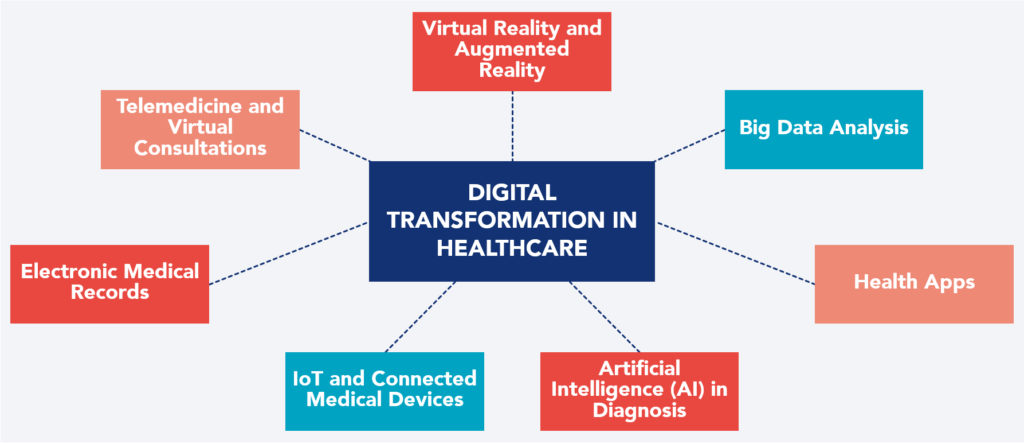The continuous evolution of digitization is swiftly transforming countless sectors, and healthcare is no exception. Digitization plays a pivotal role in optimizing healthcare operations, making them more agile and efficient.
Faced with unprecedented challenges, such as the COVID-19 pandemic, healthcare activities must adapt quickly and effectively. This article delves into how digitization can enhance the agility of operations, leading to more efficient healthcare service delivery, while improving the quality of patients’ experience.
Transforming Healthcare Through Agile Operations
In a continuously evolving healthcare landscape, agile operations play a pivotal role in transforming and improving healthcare systems. The ability to adapt swiftly and effectively is essential in addressing complex challenges currently faced by the healthcare sector. In this context, Agile has emerged as an approach that can revolutionize how healthcare is managed and delivered.
What is Agile?
Before delving into the relationship between digitization and agile operations in the healthcare sector, it’s essential to understand what Agile is.
Agile initially emerged in software development as a set of project management principles and practices. However, its application quickly expanded to other sectors, including healthcare.
Agile is a project and operations management approach grounded in principles of flexibility, collaboration, and continuous adaptation. This concept involves organizing work into short cycles known as “sprints,” typically lasting one to four weeks. During each sprint, a team sets clear, prioritized goals based on feedback from the stakeholders involved.
The essence of Agile lies in its ability to respond swiftly to changes and uncertainties, adjusting priorities and processes as new information and challenges arise. This human-centered approach values constant communication and fosters collaboration among team members, always seeking continuous improvement.
In the following sections, we will explore the benefits of Agile in healthcare and how it shapes operations to better meet patients’ and healthcare professionals’ needs.
The Benefits of Agile in Healthcare
The application of Agile principles in the healthcare sector has yielded significant benefits, transforming how healthcare services are delivered, managed, and enhanced. Some of them include:
- Increased Flexibility: Agile enables organizations to adapt to the changing needs of patients, regulations, and technological advancements. This is particularly important in a constantly evolving sector.
- Improvement in Patient Care Quality: By focusing on delivering value to the patient and continuous feedback, healthcare teams can raise the quality of care.
- Quick Value Delivery to Patients: The Agile approach allows teams to swiftly deliver gradual solutions and improvements rather than waiting for a project to be fully completed.
- Enhanced Collaboration: Collaboration is one of the foundations of Agile, which can get teams to work more effectively and share information and best practices.
- Reduction of Errors and Risks: As the approach emphasizes continuous review and feedback, it enables early identification and correction of errors and risks, decreasing the likelihood of severe issues arising.
- Improvement in Healthcare Professional Satisfaction: Agile can enhance employee satisfaction by involving healthcare professionals in the decision-making process and allowing them to have a say in the direction of projects.
- Efficient Resource Management: Agile enables organizations to allocate resources more efficiently, prioritizing initiatives that most add value.
- Transparency and Improved Communication: Through frequent meetings, monitoring of indicators, and transparency in activities, Agile fosters effective communication across the team and departments.
- Greater Operational Resilience to Crises: Agile’s ability to swiftly adapt to unexpected changes is a fundamental characteristic. This can help healthcare organizations respond more effectively to crises like epidemics or natural disasters.
Agile Operations for Patient-Centric Healthcare
Implementing agile operations in the healthcare sector is not solely about enhancing process efficiency but also about transforming the patient’s experience. Agile plays a pivotal role in promoting patient-centered healthcare:
- Patient Focus: Agile emphasizes continuous feedback collection, which extends to patients. Here, heightened patient involvement in the process is required; they are invited to provide feedback on their experience, assisting organizations in improving by offering insights and facilitating communication.
- Care Personalization: Based on patient feedback and Agile’s flexibility, treatment plans can be tailored to meet each patient’s specific needs, resulting in more effective and satisfying care.
- Quicker Access to Care: Operational agility allows for resource efficiency enhancement, thereby reducing lengthy waiting lines and ensuring patients have faster access to medical consultations, tests, and treatments.
- Multidisciplinary Collaboration: Teams consist of professionals from various disciplines, such as doctors, nurses, therapists, and admin staff. This multidisciplinary collaboration enables a holistic approach to address patient needs.
- Prevention and Early Intervention: Real-time data collection and swift response capabilities allow for the early identification of health issues and interventions before they become critical, improving outcomes and decreasing costs.
Implementing agile operations in the healthcare sector optimizes internal processes and places the patient at the heart of all operations. This leads to more effective, personalized, and patient-centered healthcare, significantly enhancing the quality of life and treatment outcomes.
The Benefits of Digital Transformation in Patient-Centric Healthcare
Digitalization is not just a concept but a reality revolutionizing healthcare delivery. Some of the benefits of digital transformation in healthcare include
- Telemedicine and Virtual Consultations: Digitalization enables patients to communicate with their doctors via virtual consultations, saving time and providing access to medical care even in remote areas.
- Electronic Medical Records (EMR): Electronic medical records make patients’ health histories accessible anytime and anywhere, enhancing care coordination.
- IoT and Connected Medical Devices: The Internet of Things (IoT) allows for remote patient monitoring and using connected medical devices to gather real-time data on patient health.
- Artificial Intelligence (AI) in Diagnosis: AI is employed for medical image analysis, disease diagnosis, and health trend prediction, enhancing the accuracy and speed of diagnosis.
- Health Applications: Mobile health apps enable patients to manage their health, track symptoms, and receive medication reminders.
- Big Data Analysis in Healthcare: Using extensive data analysis assists healthcare professionals in identifying trends, predicting disease outbreaks, and customizing treatments.
- Virtual Reality (VR) and Augmented Reality (AR): VR and AR have an impact on the activities of healthcare professionals, with benefits in diagnosis, healthcare access, education, and even cost reduction.
These developments in digital transformation not only enhance the efficiency of healthcare services but also empower patients to take a more active role in their well-being.

How Lean Fuels Agile Digitalization in Healthcare
Lean plays a pivotal role as a driving force behind agile digitization in the healthcare sector and provides the foundational elements required for effective digital transformation, optimizing processes and ensuring technology is strategically deployed.
Lean provides the principles and mindset essential for refining healthcare processes and fostering a culture of continuous improvement. Agile digitization, in turn, relies on these pillars to strategically and effectively implement technologies, propelling innovation and enhancing healthcare service quality.
Lean Principles in Healthcare
Lean methodologies in Healthcare primarily aim to implement a core set of principles designed to optimize healthcare service delivery. These principles can be summarized as follows:
- Patient Flow Optimization: Prioritize a continuous patient experience by eliminating waste and reducing waiting times. This involves designing processes that allow patients to navigate the healthcare system effectively and without unnecessary interruptions.
- Resource Efficiency: Ensure resources are allocated both efficiently and sustainably. This entails wise staff, equipment, and consumables management to prevent waste and maximize care quality.
- Integration and Digitization: Embrace digital technologies to enhance communication among healthcare professionals, simplify medical record management, and monitor patients more effectively. Digitization helps balance human labor with automated work.
- Agile Planning: Foster an organization capable of swiftly adapting to changes in patient demand and profiles. It requires flexibility and responsiveness to adjust resources and processes as needed.
- Logistical Effectiveness: Optimize logistics, ensuring the right medical supplies are available when and where they are required. This involves efficient management of the supply and distribution chain.

These principles are vital for promoting a Lean approach in healthcare, aiming to improve care quality, reduce costs, and boost patient satisfaction by leveraging available resources and adapting to changes in the healthcare environment.
Digitization Driven by Lean
As previously highlighted, digitization is a key Lean principle in the healthcare sector. The fusion of Lean with digital technologies is shaping the future of healthcare, making it more effective, patient-centered, and adaptable to change.
For healthcare institutions to achieve the most efficient balance between human and automated work, they should:
- Automate high-frequency routine processes to reduce complexity and error occurrence.
- Employ technology to enhance clinical activities, including robotics and artificial intelligence.
- Streamline transactional processes, eliminating unnecessary bureaucracy.
- Promote digital interactions throughout the patient’s journey.
- Integrate systems to enhance data access, sharing, and security.
- Fully leverage data for continuous learning and informed decision-making through analytics.
To ensure successful digitization implementation, it’s essential to improve processes before automating them, thus avoiding the automation of waste. Selecting appropriate technology for each need should prevail over adopting technology without focusing on existing needs.
This approach harmonizes operational efficiency and Lean’s continuous improvement culture with the flexibility and responsiveness provided by digitization, creating a more efficient, safe, and patient-centered healthcare environment.
Still Have Some Questions About Agility in Healthcare
What is a patient-centric approach?
A patient-centered approach, also known as patient-centered care, is a healthcare service delivery model that places the patient at the core of the care system. This approach acknowledges that the patient is the most vital element in the medical care equation and, therefore, aims to address their needs, preferences, and values in a holistic and personalized manner.
What is digital innovation?
Digital innovation is the process of integrating digital technologies and strategies into organizations, processes, products, and services to drive significant improvements, efficiency, competitiveness and, ultimately, create value for customers and stakeholders. This innovation involves creatively applying digital technologies such as artificial intelligence, data analytics, automation, Internet of Things (IoT), and blockchain, among others, to transform the way businesses operate and meet the needs of their customers.
See more on Healthcare
Find out more about transformation in this sector
See more on Operations
Find out more about improving this business area
